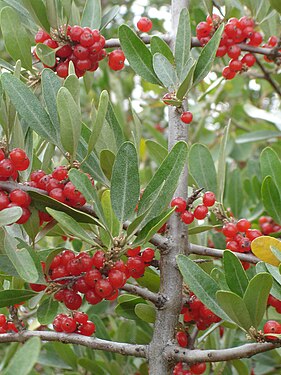Shepherdia argentea
| Habit | shrub
| |
|---|---|---|
| Height: | ⇕ | 12 ft"ft" can not be assigned to a declared number type with value 12. |
| Width: | ⇔ | 12 ft"ft" can not be assigned to a declared number type with value 12. |
| Lifespan: | ⌛ | perennial |
| Exposure: | ☼ | sun |
|---|---|---|
| Features: | ✓ | deciduous |
| USDA Zones: | 2 to 9 | |
| Flower features: | ❀ | white |
|
argentea > |
Shepherdia argentea (Silver Buffaloberry or Bull berry, thorny buffaloberry) is a species of Shepherdia, native to central North America from southern Canada (Alberta, Saskatchewan, Manitoba) south in the United States to northern California and New Mexico.[1]
It is a deciduous shrub growing to 2–6 m tall. The leaves are arranged in opposite pairs (rarely alternately arranged), 2–6 cm long, oval with a rounded apex, green with a covering of fine silvery, silky hairs, more thickly silvery below than above. The flowers are pale yellow, with four sepals and no petals. The fruit is a bright red fleshy drupe 5 mm in diameter; it is edible but with a rather bitter taste.[2]
ExpandRead about Shepherdia argentea in the Standard Cyclopedia of Horticulture
|
|---|
Cultivation
A decidious Shrub growing to 4m by 4m at a medium rate.
It is hardy to zone 2 and is not frost tender. It is in flower in March, and the seeds ripen from July to December. The flowers are dioecious (individual flowers are either male or female, but only one sex is to be found on any one plant so both male and female plants must be grown if seed is required)The plant is not self-fertile. It can fix Nitrogen.
The plant prefers light (sandy), medium (loamy) and heavy (clay) soils, requires well-drained soil and can grow in nutritionally poor soil. The plant prefers acid, neutral and basic (alkaline) soils. It can grow in semi-shade (light woodland) or no shade. It requires dry or moist soil and can tolerate drought. The plant can tolerate maritime exposure.
Succeeds in an ordinary well-drained moisture retentive soil[1, 3, 11]. Tolerates poor dry soils[200] and maritime exposure[182]. Established plants are drought resistant[182]. A very cold-tolerant plant[229]. Plants rarely produce fruit in Britain[11]. Occasionally cultivated for its edible fruit, there are some named varieties[183]. 'Xanthocarpa' has yellow fruits[200]. The fruit is difficult to harvest because the shrub is very thorny[3]. Plants in this genus are notably resistant to honey fungus[200]. This species has a symbiotic relationship with certain soil bacteria, these bacteria form nodules on the roots and fix atmospheric nitrogen. Some of this nitrogen is utilized by the growing plant but some can also be used by other plants growing nearby[200]. Dioecious. Male and female plants must be grown if fruit and seed are required.
Propagation
Seed - it must not be allowed to dry out[113]. It is best harvested in the autumn and sown immediately in a cold frame. Stored seed requires 2 - 3 months cold stratification[113]. Prick out the seedlings into individual pots once they are large enough to handle. If sufficient growth is made it will be possible to plant them out in the summer, otherwise grow them on in a cold frame for their first winter and plant them out in the following spring or early summer. Cuttings of half-ripe wood, July/August in a frame sometimes work[113].
Pests and diseases
- Do you have pest and disease info on this plant? Edit this section!
Varieties
Gallery
References
- Plants for a Future - creative commons text incorporated
- Standard Cyclopedia of Horticulture, by L. H. Bailey, MacMillan Co., 1963
External links
- w:Shepherdia argentea. Some of the material on this page may be from Wikipedia, under the Creative Commons license.
- Shepherdia argentea QR Code (Size 50, 100, 200, 500)
- ↑ Germplasm Resources Information Network: Shepherdia argentea
- ↑ Jepson Flora: Shepherdia argentea




